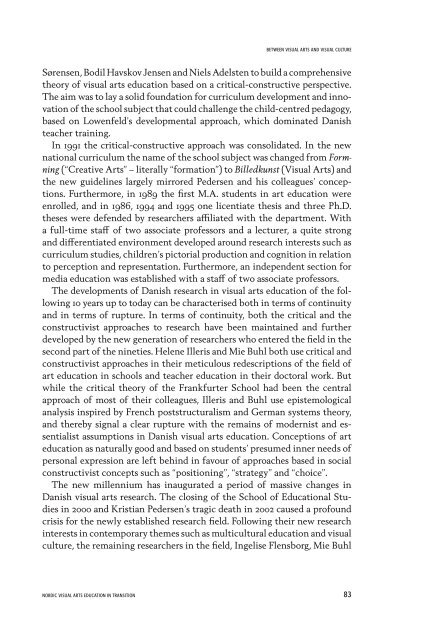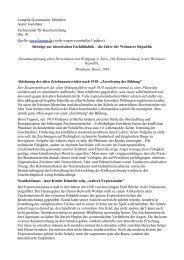Research in Visual Arts Education - The National Society for ...
Research in Visual Arts Education - The National Society for ...
Research in Visual Arts Education - The National Society for ...
You also want an ePaper? Increase the reach of your titles
YUMPU automatically turns print PDFs into web optimized ePapers that Google loves.
BETWEEN VISUAL ARTS AND VISUAL CULTURE<br />
Sørensen, Bodil Havskov Jensen and Niels Adelsten to build a comprehensive<br />
theory of visual arts education based on a critical-constructive perspective.<br />
<strong>The</strong> aim was to lay a solid foundation <strong>for</strong> curriculum development and <strong>in</strong>novation<br />
of the school subject that could challenge the child-centred pedagogy,<br />
based on Lowenfeld’s developmental approach, which dom<strong>in</strong>ated Danish<br />
teacher tra<strong>in</strong><strong>in</strong>g.<br />
In 1991 the critical-constructive approach was consolidated. In the new<br />
national curriculum the name of the school subject was changed from Formn<strong>in</strong>g<br />
(“Creative <strong>Arts</strong>” – literally “<strong>for</strong>mation”) to Billedkunst (<strong>Visual</strong> <strong>Arts</strong>) and<br />
the new guidel<strong>in</strong>es largely mirrored Pedersen and his colleagues’ conceptions.<br />
Furthermore, <strong>in</strong> 1989 the first M.A. students <strong>in</strong> art education were<br />
enrolled, and <strong>in</strong> 1986, 1994 and 1995 one licentiate thesis and three Ph.D.<br />
theses were defended by researchers affiliated with the department. With<br />
a full-time staff of two associate professors and a lecturer, a quite strong<br />
and differentiated environment developed around research <strong>in</strong>terests such as<br />
curriculum studies, children’s pictorial production and cognition <strong>in</strong> relation<br />
to perception and representation. Furthermore, an <strong>in</strong>dependent section <strong>for</strong><br />
media education was established with a staff of two associate professors.<br />
<strong>The</strong> developments of Danish research <strong>in</strong> visual arts education of the follow<strong>in</strong>g<br />
10 years up to today can be characterised both <strong>in</strong> terms of cont<strong>in</strong>uity<br />
and <strong>in</strong> terms of rupture. In terms of cont<strong>in</strong>uity, both the critical and the<br />
constructivist approaches to research have been ma<strong>in</strong>ta<strong>in</strong>ed and further<br />
developed by the new generation of researchers who entered the field <strong>in</strong> the<br />
second part of the n<strong>in</strong>eties. Helene Illeris and Mie Buhl both use critical and<br />
constructivist approaches <strong>in</strong> their meticulous redescriptions of the field of<br />
art education <strong>in</strong> schools and teacher education <strong>in</strong> their doctoral work. But<br />
while the critical theory of the Frankfurter School had been the central<br />
approach of most of their colleagues, Illeris and Buhl use epistemological<br />
analysis <strong>in</strong>spired by French poststructuralism and German systems theory,<br />
and thereby signal a clear rupture with the rema<strong>in</strong>s of modernist and essentialist<br />
assumptions <strong>in</strong> Danish visual arts education. Conceptions of art<br />
education as naturally good and based on students’ presumed <strong>in</strong>ner needs of<br />
personal expression are left beh<strong>in</strong>d <strong>in</strong> favour of approaches based <strong>in</strong> social<br />
constructivist concepts such as “position<strong>in</strong>g”, “strategy” and “choice”.<br />
<strong>The</strong> new millennium has <strong>in</strong>augurated a period of massive changes <strong>in</strong><br />
Danish visual arts research. <strong>The</strong> clos<strong>in</strong>g of the School of <strong>Education</strong>al Studies<br />
<strong>in</strong> 2000 and Kristian Pedersen’s tragic death <strong>in</strong> 2002 caused a profound<br />
crisis <strong>for</strong> the newly established research field. Follow<strong>in</strong>g their new research<br />
<strong>in</strong>terests <strong>in</strong> contemporary themes such as multicultural education and visual<br />
culture, the rema<strong>in</strong><strong>in</strong>g researchers <strong>in</strong> the field, Ingelise Flensborg, Mie Buhl<br />
NORDIC VISUAL ARTS EDUCATION IN TRANSITION 83



